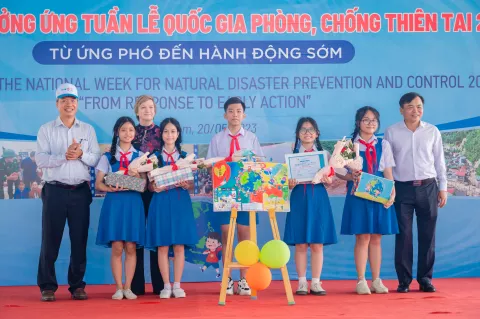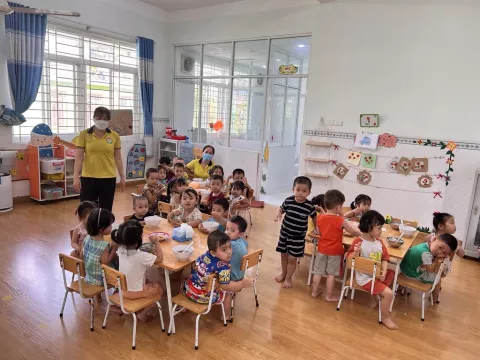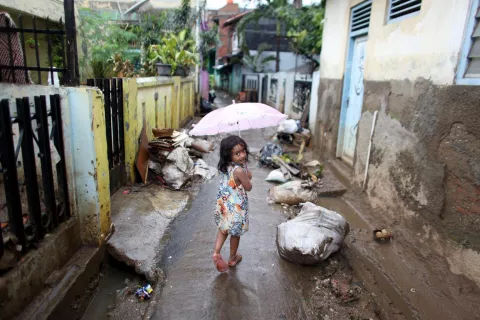Weather-related disasters led to 43.1 million displacements of children over six years – UNICEF
Viet Nam is among the top ten countries with the highest recorded absolute numbers of child displacements

- Available in:
- English
- Tiếng Việt
NEW YORK/BANGKOK / HA NOI, 6 October 2023 – Weather-related disasters caused 43.1 million internal displacements of children in 44 countries over a six-year period – or approximately 20,000 child displacements a day - according to a new UNICEF analysis released today.
Children Displaced in a Changing Climate is the first global analysis of the number of children driven from their homes between 2016 and 2021 due to floods, storms, droughts and wildfires, and looks at projections for the next 30 years.
Floods and storms accounted for 40.9 million - or 95 per cent - of recorded child displacements globally between 2016 and 2021, due in part to better reporting and more pre-emptive evacuations. Meanwhile, droughts triggered more than 1.3 million internal displacements of children, while wildfires triggered 810,000 child displacements.
“It is terrifying for any child when a ferocious wildfire, storm or flood barrels into their community,” said UNICEF Executive Director Catherine Russell. “For those who are forced to flee, the fear and impact can be especially devastating, with worry of whether they will return home, resume school, or be forced to move again. Moving may have saved their lives, but it’s also very disruptive. As the impacts of climate change escalate, so too will climate-driven movements. We have the tools and knowledge to respond to this escalating challenge for children, but we are acting far too slowly. We must strengthen efforts to prepare communities, protect children at risk of displacement, and support those already uprooted.”
According to the analysis, East Asia and the Pacific experienced an estimated 19 million child displacements linked to weather-related disasters between 2016 and 2021, representing more than 44 per cent of the global total. Most displacements of children in East Asia and the Pacific were triggered by floods, which led to over 12 million displacements, and storms, which led to over 6 million displacements.
Viet Nam, together with other countries in the region such as China, the Philippines and Indonesia, is among the top ten countries that recorded the highest absolute numbers of child displacements, due to the exposure to extreme weather, large child populations and progress made on early warning and evacuation capacities. However, relative to the size of the child population, children living in small island states, such as Vanuatu, Fiji, Palau and Northern Mariana Islands were most affected by storms.
Between 2016 and 2021, around 930,000 children in Viet Nam were displaced due to various hazards such as floods, storms and drought. ”Evidence from each of the disasters striking Viet Nam confirms over and again that children are highly exposed to the impacts of the climate crisis, not just their health but every aspect of their development is affected. It is essential that as the country makes the critical and urgent switch to green energy, there are increased efforts and resources to create climate-resilient communities across Viet Nam”, said Rana Flowers, UNICEF Representative to Viet Nam
Decisions to move can be forced and abrupt in the face of disaster or as the result of pre-emptive evacuation, where lives may be saved but many children still face the dangers and challenges that come with being uprooted from their homes, often for extended periods.
Displacement, whether short-lived or protracted, can exacerbate climate-related risks for children and their families. In the aftermath of a disaster, children may become separated from their parents or caregivers, amplifying the risks of exploitation, child trafficking, and abuse. It can also disrupt access to education, healthcare, and safe water and sanitation, exposing children to malnutrition, disease, and inadequate immunization.
Using a disaster displacement risk model developed by the Internal Displacement Monitoring Centre, the report projects riverine floods have the potential to displace almost 96 million children over the next 30 years, based on current climate data, while cyclonic winds and storm surges have the potential to displace 10.3 million and 7.2 million children respectively, over the same period*. With more frequent and more severe weather events as a consequence of changing climate, the actual numbers will almost certainly be higher.
UNICEF works with governments to better prepare for and minimize the risk of displacement, develop and implement child-responsive disaster risk reduction climate change adaptation strategies, and design resilient and portable services to protect and reach children before, during and after disaster strikes, catering solutions to address context-specific vulnerabilities.
There are practical, life-saving steps that prepare communities and build resilience in children and adults. For example, school readiness approaches or the construction of flood and drought-resistant water and sanitation systems. Preparedness work is done in non-emergency times, requiring each of the social sectors, education, health and nutrition, water, social protection and child and women protection to build resilience in the communities today, with plans for quick response when a disaster strikes. “This includes ensuring that all children are immunized, wind-resistant tents and life-saving nutrition products are stockpiled and ready to roll out. Reducing the risks from disasters is a whole of Government accountability, and when done well is a consistent part of long-term strategies that aim to build climate-resilient communities”, Flowers added.
As leaders prepare to meet at the COP28 Climate Change Summit in Dubai in November, UNICEF urges governments, donors, development partners, and the private sector to take the following actions to protect children and young people at risk of future displacement and prepare them and their communities:
- PROTECT children and young people from the impacts of climate change-exacerbated disasters and displacement by ensuring that child-critical services – including education, health, nutrition, social protection and child protection services – are shock-responsive, portable and inclusive, including for those already uprooted from their homes.
- PREPARE children and young people to live in a climate-changed world by improving their adaptive capacity and resilience and enabling their participation in finding inclusive solutions.
- PRIORITIZE children and young people – including those already uprooted from their homes – in disaster and climate action and finance, humanitarian and development policy, and investments to prepare for a future already happening.
#####
Notes to Editors:
- Read and download the report here once the embargo lifts
- Photos, b-roll and other multimedia assets, including stories from families impacted, are available here
*Because the definition of the hazards considered in the projections are different to those in the historic analysis it is not possible to directly compare the two. The projections also do not include pre-emptive evacuations.
UNICEF analysed data from the Internal Displacement Monitoring Centre (IDMC) to determine historical child displacements linked to weather-related disasters and projected the estimated risk of child displacement in the future using IDMC’s risk model. The work was completed with support from the Patrick J McGovern Foundation.
For more information, please contact:
- Raquel Fernandez, UNICEF Việt Nam, +84 (024) 3850 0100; ĐT: +84 (0)98 549 9748 email: rafernandez@unicef.org
- Nguyễn Thị Thanh Hương, UNICEF Việt Nam, +84 (024) 38500225; +84 (0)904154678; email: ntthuong@unicef.org
Media contacts
About UNICEF
UNICEF promotes the rights and well-being of every child, in everything we do. Together with our partners, we work in 190 countries and territories to translate that commitment into practical action, focusing special effort on reaching the most vulnerable and excluded children, to the benefit of all children, everywhere. For more information about COVID-19, visit https://www.unicef.org/vietnam/covid-19
For more information about UNICEF and its work for children, visit https://www.unicef.org/vietnam
Follow UNICEF on Facebook, Instagram, Twitter, Youtube, LinkedIn and TikTok




